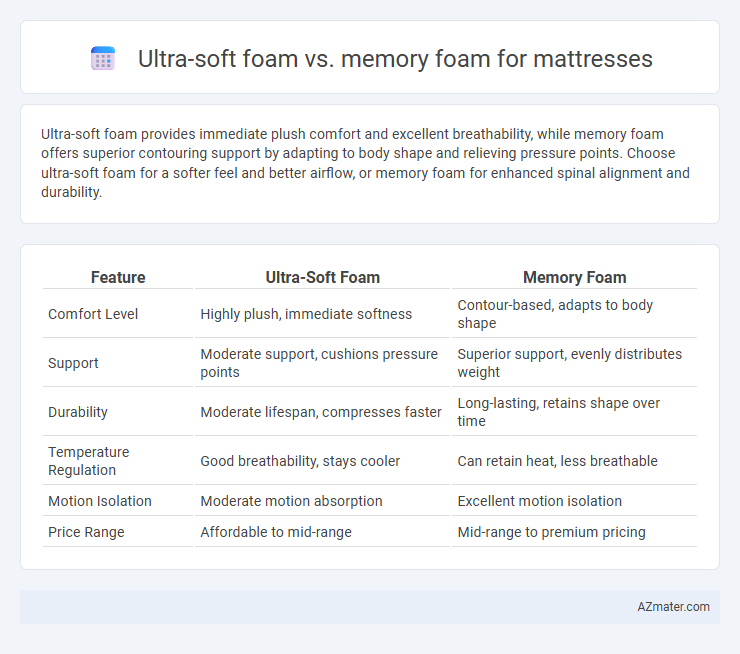Ultra-soft foam provides immediate plush comfort and excellent breathability, while memory foam offers superior contouring support by adapting to body shape and relieving pressure points. Choose ultra-soft foam for a softer feel and better airflow, or memory foam for enhanced spinal alignment and durability.
Table of Comparison
| Feature | Ultra-Soft Foam | Memory Foam |
|---|---|---|
| Comfort Level | Highly plush, immediate softness | Contour-based, adapts to body shape |
| Support | Moderate support, cushions pressure points | Superior support, evenly distributes weight |
| Durability | Moderate lifespan, compresses faster | Long-lasting, retains shape over time |
| Temperature Regulation | Good breathability, stays cooler | Can retain heat, less breathable |
| Motion Isolation | Moderate motion absorption | Excellent motion isolation |
| Price Range | Affordable to mid-range | Mid-range to premium pricing |
Introduction to Ultra-Soft Foam and Memory Foam
Ultra-soft foam offers exceptional cushioning with a plush and breathable structure that enhances comfort by reducing pressure points. Memory foam, known for its viscoelastic properties, contours precisely to body shape, providing superior support and motion isolation. Both materials are widely used in mattress manufacturing, catering to different preferences in softness, responsiveness, and temperature regulation.
Understanding Ultra-Soft Foam Mattress Technology
Ultra-soft foam mattress technology utilizes highly responsive, low-density polyurethane foam that contours gently to the body, providing immediate cushioning and pressure relief. Unlike memory foam, which relies on viscoelastic properties to conform slowly under heat and pressure, ultra-soft foam delivers a more buoyant and breathable sleeping surface that reduces heat retention. This advanced foam structure enhances airflow and durability while offering a plush, cloud-like comfort ideal for side sleepers seeking sensitive joint support.
What is Memory Foam and How Does It Work?
Memory foam is a viscoelastic polyurethane material known for its high-density structure that responds to body heat and pressure, contouring precisely to the sleeper's shape. This adaptive quality helps distribute body weight evenly, reducing pressure points and enhancing spinal alignment for improved comfort. Unlike ultra-soft foam, which offers a plush but less conforming surface, memory foam provides tailored support by molding to individual body contours, promoting better sleep quality and pain relief.
Comfort Comparison: Ultra-Soft Foam vs Memory Foam
Ultra-soft foam provides a plush, cushiony surface that conforms gently to the body's contours, promoting immediate comfort and a cloud-like sleeping experience. Memory foam, known for its viscoelastic properties, offers superior pressure relief by molding closely to the sleeper's shape and evenly distributing weight, which reduces stress on joints. The choice between ultra-soft foam and memory foam hinges on preference for either a softer initial feel or enhanced support and alignment for long-term comfort.
Support and Pressure Relief Differences
Memory foam offers superior pressure relief by conforming closely to body contours, which distributes weight evenly and reduces pressure points. Ultra-soft foam provides a plush, cushioned feel but lacks the deep support and contouring benefits found in memory foam. For individuals seeking enhanced spinal alignment and support, memory foam is typically more effective than ultra-soft foam.
Temperature Regulation: Which Stays Cooler?
Ultra-soft foam mattresses often provide better temperature regulation due to their open-cell structure that promotes airflow, preventing heat retention during sleep. Memory foam tends to retain body heat because of its dense, viscous material that molds closely to the body, which can lead to a warmer sleeping surface. Advanced cooling technologies, such as gel infusions or copper additives in memory foam, can improve temperature management but typically don't match the natural breathability of ultra-soft foam.
Durability and Longevity of Mattress Materials
Ultra-soft foam mattresses offer immediate comfort but tend to compress and lose shape faster than memory foam, impacting overall durability. Memory foam mattresses provide superior longevity due to their high-density composition, retaining support and resilience over extended periods. Choosing memory foam maximizes mattress lifespan by resisting sagging and maintaining structural integrity.
Motion Isolation: Ideal Choice for Couples
Ultra-soft foam provides gentle cushioning but tends to transfer motion more easily, making it less ideal for couples seeking minimal disturbance. Memory foam excels in motion isolation by contouring to the body and absorbing movement, significantly reducing partner sleep interruptions. For couples prioritizing uninterrupted sleep, memory foam mattresses offer superior motion isolation performance compared to ultra-soft foam options.
Price and Value Considerations
Ultra-soft foam mattresses typically offer a lower price point compared to memory foam, making them a budget-friendly choice for shoppers prioritizing cost. Memory foam provides superior contouring and pressure relief, often resulting in higher initial expenses but greater long-term value through enhanced durability and comfort. Evaluating price against longevity and comfort benefits is essential to determine the best mattress investment.
Choosing the Right Foam Mattress for Your Sleep Needs
Ultra-soft foam mattresses provide gentle cushioning ideal for side sleepers seeking pressure relief, while memory foam mattresses offer adaptive support by molding to the body's contours, benefiting those with back pain or joint issues. Selecting the right foam depends on factors such as body weight, preferred sleeping position, and desired firmness level, with medium-density memory foam balancing comfort and support for most users. Prioritize mattresses with CertiPUR-US certified foam for durability, breathability, and minimal off-gassing to enhance overall sleep quality.

Infographic: Ultra-soft foam vs Memory foam for Mattress
 azmater.com
azmater.com